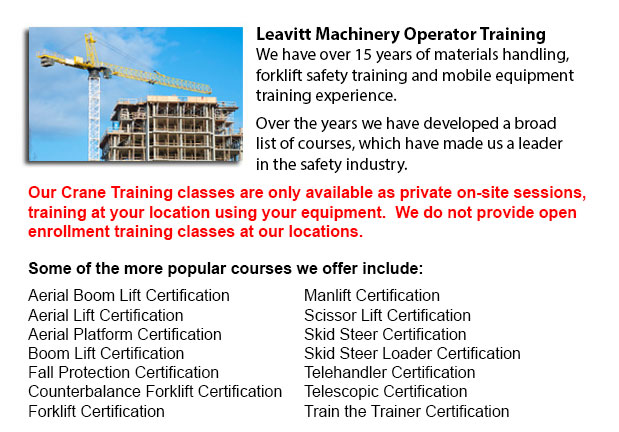
Overhead Crane Training Edmonton - An overhead crane is a big crane made use of to lift and move big, heavy objects that can't be moved by hand. An overhead crane is typically fixed in place while in use. These machinery are capable of moving huge volumes of material. Overhead cranes are normally used in steel mills to handle the steel in the process of fabrication. These cranes are seen at ports all over the world, moving things on and off ships.
Overhead cranes are made to have a beam or rail permanently fixed on a support structure. A crane could be built right into a structure. Alternatively, a platform could be built to hold the beam in place. The fixed design of overhead cranes gives them great stability, which enables them to handle the extremely heavy loads needed in heavy industries like for example steel and shipping. Several types of mobile overhead cranes are made to be pulled by large vehicles.
The overhead crane operates via a device mounted on a trolley, that runs along the rail. An overhead crane is designed to run just back and forth. Materials are lowered and lifted by running cable or rope through the trolley-mounted device, and after that horizontally moved along the rail. This back and forth movement is sufficient. Like for instance, at a port, a container ship is positioned next to the crane, and the operator of the crane sends the device back and forth along the trolley in order to transport goods between a truck or train and the ship. Jib cranes are more flexible and have swinging booms for moving merchandise in multiple directions.
The overhead crane's history goes back to the eighteen seventies, at which time, there were some designs which were implemented in a variety of uses. There are smaller overhead cranes models that are used in setting which need the lifting of heavy supplies. A home workshop, like for example, may require the use of an overhead crane in order to transport wood, finished products and tools between the workshop and loading area. Regardless of the use, overhead cranes should only be made use of by people who have received overhead crane training.
-
Forklift Training Programs Edmonton
Forklift Training Programs Edmonton - If you are searching for work as an operator of a forklift, our regulatory-compliant lift truck training programs provide excellent instruction in numerous styles and types of forklifts, classes on pre-shift insp... More -
Heavy Equipment Training School Edmonton
Heavy Equipment Training School Edmonton - The heavy equipment operator courses will assist the operator in acquiring the required skills and knowledge they will require to be able to enter the workforce as an entry level operator. In this 12 week co... More -
Manlift Ticket Edmonton
Manlift Ticket Edmonton - The Elevated Platforms and Manlifts Certification program helps to provide the necessary training on the safe operating procedures, work practice, rules and regulations regarding the daily activities for the operators of thi... More -
Crane License Edmonton
Crane License Edmonton - Crane operators must be "credentialed", which means they must have a crane operator license or certification. Credentialing is considered a mandatory governmental requirement in order to practice as a crane operator. Having a... More -
Counterbalance Forklift License Edmonton
Counterbalance Forklift License Edmonton - When operated by totally trained operators, forklifts could become a major advantage for firms and companies. We could offer your staff a comprehensive training program which covers all aspects of operating... More -
Manlift Safety Training Edmonton
Manlift Safety Training Edmonton - Manlift operators have to be aware and cognizant of all the potential hazards which are associated with particular types of scissor lifts. They need to be able to operate the scissor lift in a way that protects not... More -
Forklift Training School Edmonton
Forklift Training School Edmonton - Forklift Training School And Reasons Why It Is Really Important - Industry and federal regulators have established the criteria for forklift safety training based on their existing standards and regulations. Indivi... More -
Overhead Crane Safety Training Edmonton
Overhead Crane Safety Training Edmonton - The overhead crane safety training course is designed to equip the operators with the right skills and knowledge in the areas of: crane safety precautions, materials handling, accident avoidance, and equipmen... More

Forklift Training Edmonton
crossorigin="anonymous">
TOLL FREE: 1-888-254-6157
Edmonton, Alberta
forklifttrainingedmonton.com
Email Us
About Us


